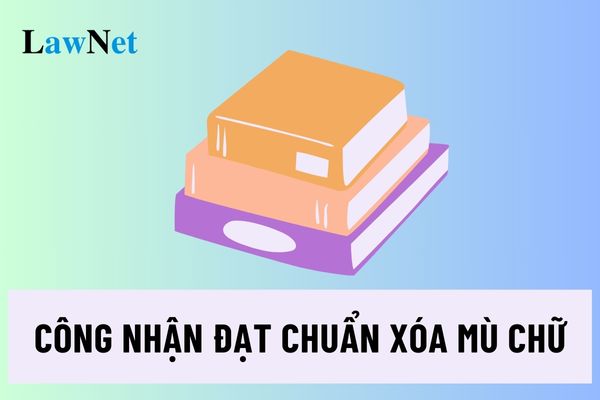Vietnam: What are the two levels of recognition for commune-level standardized illiteracy eradication?
What are the two levels of recognition for commune-level standardized illiteracy eradication in Vietnam?
According to Article 20 of Decree 20/2014/ND-CP, the regulations are as follows:
Criteria for individuals to be recognized as standardized illiteracy eradication at level 1
1. For communes: At least 90% of people from 15 to 35 years old are recognized as standardized literates at level 1 and at least 90% for communes with extremely difficult social-ecomic conditions with people from 15 to 25 years old to be recognized as standardized literates at level 1.
2. For districts: At least 90% of communes are recognized as standardized illiteracy eradication at level 1.
3. For provinces: At least 90% of districts are recognized as standardized illiteracy eradication at level 1.
According to Article 21 of Decree 20/2014/ND-CP, the regulations are as follows:
Criteria for individuals to be recognized as standardized illiteracy eradication at level 2
1. For communes: At least 90% of people from 15 to 60 years old are recognized as standardized literates at level 2 and at least 90% for communes with extremely difficult social-ecomic conditions with people from 15 to 35 years old to be recognized as standardized literates at level 2.
2. For districts: At least 90% of communes are recognized as standardized illiteracy eradication at level 2;
3. For provinces: There must be 100% of districts recognized as standardized illiteracy eradication at level 2.
Thus, the two levels of recognition for commune-level standardized illiteracy eradication in Vietnam include:
Level 1: At least 90% of people from 15 to 35 years old are recognized as standardized literates at level 1 and at least 90% for communes with extremely difficult social-ecomic conditions with people from 15 to 25 years old to be recognized as standardized literates at level 1.
Level 2: At least 90% of people from 15 to 60 years old are recognized as standardized literates at level 2 and at least 90% for communes with extremely difficult social-ecomic conditions with people from 15 to 35 years old to be recognized as standardized literates at level 2

What are the two levels of recognition for commune-level standardized illiteracy eradication in Vietnam? (Image from the Internet)
Does the Illiteracy Eradication Program in Vietnam help learners have consciousness and responsibility towards themselves?
Under Section 1, Part 1 of the Illiteracy Eradication Program issued together with Circular 33/2021/TT-BGDDT:
OBJECTIVES OF THE ILLITERACY ELIMINATION PROGRAM
The Illiteracy Eradication Program provides learners with basic, necessary knowledge and skills to:
- Help learners form and develop essential qualities with specific manifestations: love for the homeland and country, awareness of preserving the national cultural identity, consciousness, and responsibility towards oneself, family, and the community.
- Help learners initially form common competencies and develop language competency in all skills of reading, writing, speaking, and listening at a basic level: reading correctly and fluently; understanding the content and main information of the text; making connections and comparisons outside the text; writing correctly grammatically and orthographically; being able to write some sentences, paragraphs, short essays; speaking clearly; comprehending others' opinions.
- Contribute to forming and developing mathematical competency with the required levels: performing thought processes at a simple level; selecting arithmetic operations and formulas to present, express the content, ideas, and solutions; using mathematical language, simple learning tools, and means to complete basic mathematical learning tasks.
- Help learners gradually form and develop natural science competencies through observation and experimentation, integrating knowledge and skills to solve life problems; knowing how to respect natural laws and behave with nature suitably for sustainable environmental and social development. Form and develop social science competencies through the ability to perceive social sciences, understand society and apply learned knowledge and skills to explore and discover oneself, the community, and society, analyzing and solving social problems.
- Help learners form and develop technology and informatics competencies through activities: recognizing technology; using technology; managing and utilizing information and communication technology tools; applying information and communication technology in learning and self-study.
The Illiteracy Eradication Program helps learners form and develop essential qualities, including consciousness and responsibility towards themselves.
What is the total duration of the Illiteracy Eradication Program in Vietnam?
Under Subsection 1, Section 3, Part 1 of the Illiteracy Eradication Program issued together with Circular 33/2021/TT-BGDDT, the Illiteracy Eradication Program is divided into two phases as follows:
Phase 1: Includes 03 subjects (Vietnamese, Mathematics, Natural and Social). Total duration is 1,005 lessons; divided into 03 semesters (semester 1, semester 2, semester 3).
Phase 2: Includes 04 subjects (Vietnamese, Mathematics, Science, History, and Geography). Total duration is 949 lessons; divided into 02 semesters (semester 4, semester 5). Semester 5 includes elective study topics within the total duration of the subject.
Thus, the total duration of the Illiteracy Eradication Program is 1,954 lessons.

